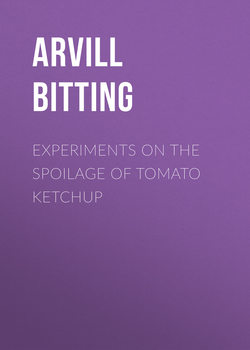Читать книгу Experiments on the Spoilage of Tomato Ketchup - Arvill Wayne Bitting - Страница 3
CHARACTER OF PRODUCTS
ОглавлениеFIRST-CLASS PRODUCTS
The factory at which the experiments were conducted has sanitary buildings and surroundings, the floors are of concrete for flushing, and the pipes used in conducting the pulp to the kitchens are porcelain-lined to prevent discoloration from the iron and to insure cleanliness. The tubes which carry the ketchup from the kettles to the receiving tank, finishing machine, and bottler are silver-plated. Not all of these measures are necessary to make a good ketchup, but they show the care exercised in making an article of good appearance and of the finest quality.
The conditions under which ketchup is made and the care with which the work is done at some of the better factories is equal to that used in the manufacture of any food product. Whole selected fruit is used, cleanliness is maintained at every point, the best grades of spices, vinegar, granulated sugar, and salt are added for flavoring, and the bottles are carefully washed. The ketchup put up under such conditions will have a bright natural color, will remain good as long as the container is unbroken, and will continue in that condition for some time after opening if kept at a fairly cool temperature.
INFERIOR PRODUCTS FROM “TRIMMING STOCK.”
In contrast with the strictly high-grade product is the great bulk of the ketchup found on the market. The material is not whole ripe tomatoes, but consists of the waste of the canning factory, commonly designated as “trimming stock,” including the green, moldy, broken, rotten, and generally unusable tomatoes, the skins, cores, and stems from the peeling tables, and the surplus juice from the filling machines, all of which may be allowed to stand during the day and be run through the cyclone in the evening. At the end of the season, the frosted and half-ripe fruits may be used. Part of this material can not be considered “sound fruit” as contemplated by the food and drugs act. The pulp is put up in barrels, preserved, and allowed to stand, possibly in the sun, until a sufficient quantity has accumulated for shipment. Old ketchup barrels may be used and be none too clean. As a result, it is not uncommon to see an inch or more of pulp in the bottom of a car at the end of shipment, caused by the blowing out of the barrel heads from fermentation. The sanitary condition of the factory may be poor, the handling of the goods be unclean, the spices be the refuse from the spice houses, the sugar be of the cheapest grade, and the bottles be only rinsed or be used without even that precaution. The ketchup is a concoction so heavily spiced with hot spices that the tomato flavor is lost and might as well be anything else. The color is normally dirty brown.
Between these two extremes are all grades, those for which whole tomatoes, unsorted, are used, those for which trimming stock is worked up promptly during the canning season, and those made from stock of unknown history. Some manufacturers work under good and some under poor sanitary conditions. There can be no doubt that with proper selection and precaution much of the by-product of the canning factory and large quantities of tomatoes which are unsuitable for canning might be used to advantage in the manufacture of ketchup; but it requires a nicety of practice not generally found at this time. The practice sometimes followed of making some ketchup from whole stock and a large quantity from refuse and using the former for advertising purposes, only serves to emphasize the fact that the goods belong to two distinct classes. One of the uses for a very considerable amount of pulp from refuse stock is the making of sauce for baked beans and other canned goods where the true character can not be observed by the consumer.
During the season tomatoes come in at times in larger quantities than can be made into ketchup promptly. The surplus must be worked up into pulp for storage and may be stored in barrels or in tin cans. The pulp stored in barrels will not have as good a color as that put into cans, and the ketchup made from either will not be as bright as that made from whole, fresh stock. The pulp put up in barrels is more liable to spoilage than that put up in cans. The difference in the cost of storage by the two methods is not very great, and some large concerns are using the can exclusively instead of the barrel.
